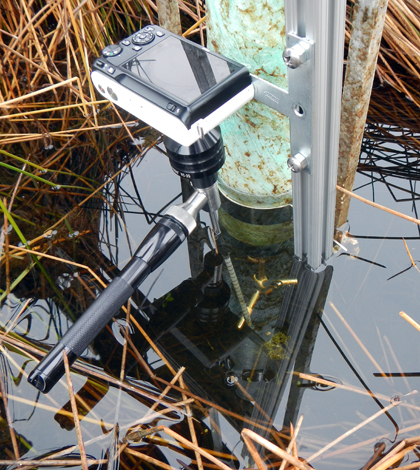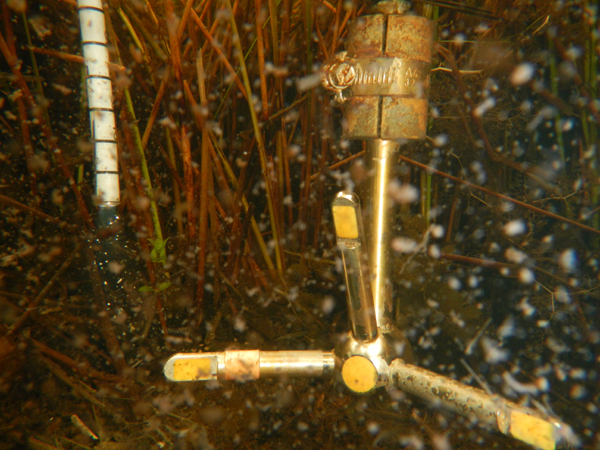New sensor captures intricacies of wetland flow; engineered wetlands could especially benefit

This version of the volumetric particle imager tracks small-scale wetland flow with a Nikon camera, Maglite light source and Hawkeye Pro Hardy borescope. (Credit: Evan Variano)
Resource managers are putting engineered wetlands and their natural chemical processing power to work for a wide variety of environmental benefits. Scientists at University of California Berkeley have developed a sensor to help engineers make sure those wetlands are fine-tuned to do their job.
Artificial wetlands are an ideal strategy for mitigating the effects of environmental degradation for their ability to breakdown or store nutrients, pollutants and other chemicals.
“You’re relying on the wetland’s bioreactor process to provide the typical wetland performance, which is huge amounts of biological productivity,” said Evan Variano, assistant professor of civil and environmental engineering at the University of California Berkeley.
Variano has colleagues in the San Joaquin-Sacramento River Delta using an engineered wetland to break down pharmaceuticals in wastewater effluent that aren’t removed by the treatment process. A USGS project in the same region is using a wetland to sequester carbon dioxide. Each application has it’s own management and engineering requirements.
“You want to get a lot of free radicals in the wetland surface water if you’re doing pharmaceutical breakdown,” he said. “You want to reduce methane emissions if you’re doing carbon capture farming.”
Scientists have to monitor the wetlands to make sure they’re behaving the right way to do the job they were built for. The way water flows through a wetland is particularly important, and Variano and his collaborators have designed a sensor to monitor those flows like never before possible.
The sensor combines an off-the-shelf camera and borescope with custom optics and code to track the three-dimensional trajectories of natural particles in the water. Those trajectories can give a sense of the magnitude and direction of the average flow at a specific point as well as a sense of the variance.
Another flow monitoring tool, the acoustic Doppler velocimeter, is one of the go-to instruments for high-precision measurements. But they aren’t designed to capture the slow flow rates of wetlands at high resolution.
“Fast-moving wetlands are still going to be under a centimeter a second,” Variano said. “And typically a wetland will be under a millimeter per second.”
Variano’s tool, which he calls a volumetric particle imager, can capture those small-scale flows and the variations within them.
Though wetland flows generally aren’t turbulent, the particles in the water still have have tortuous, winding paths. A look at the trajectories produced by the sensor and data processing methods make that clear. One might show a particle moving quickly through the sample volume, while another wanders around before leaving the picture. Another trajectory of a particle rocking back and forth suggests a period of wave action on the surface.

The volumetric particle imager next to a Sontek Argonaut ADV and surrounded by particles illuminated by the VoPI’s light source (Credit: Evan Variano)
The sensor produces video footage, which operators can review to eliminate non-flow-related motion from skewing the results of the automated data processing.
“Wetlands are absolutely teeming with life, much of which is locomoting of it’s own accord,” Variano said. “So we see a species of Gambusia swim by, we know that’s a fish and we’re not going to count the fish motion as water motion.”
With all the fish and copepods out of the picture, the data processing procedure can calculate the mean flow in and out of the wetland as well as the otherwise imperceptible stirring going on.
“There is a lot of short-term, small-amplitude, high-frequency motion from waves, from thermal convection, from the wake left by fish, from the wind stirring the water surface,” Variano said. “All these things are keeping the wetland quite a bit more thoroughly mixed than one would expect.”
Deployments so far have shown that this mixing is often vertical, which keeps the atmosphere and oxygen-rich surface waters in greater contact with the sediment and oxygen-poor bottom waters than could be assumed from coarser flow measurements. Insights like that can have an important influence on how well a wetland is performing it’s bioreactor role.
Variano said that the technology and methods can be licensed through the UC Berkeley Office of Technology, including free licensing for academic users. The principle behind the sensor and image analysis are also published in the journal Limnology and Oceanography: Methods. CITRIS, UC Berkeley’s Department of Civil and Environmental Engineering, the National Science Foundation and the Hellman Family Foundation supported development.
Top image: This version of the volumetric particle imager tracks small-scale wetland flow with a Nikon camera, Maglite light source and Hawkeye Pro Hardy borescope. (Credit: Evan Variano)




0 comments